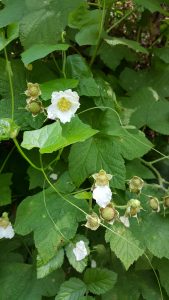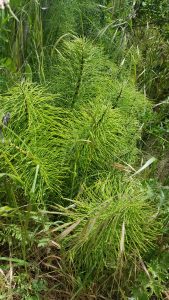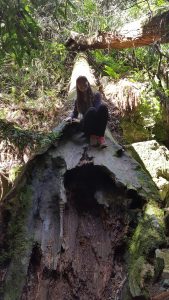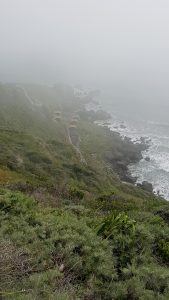Mount Tamalpais (Steep Ravine): 37.88775, -122.62418
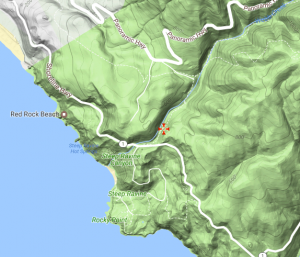
We visited Mount Tamalpais once again, but this time we visited a particular area near Stinson Beach. We used the Steep Ravine trail, which led us through both a hardwood riparian forest and a redwood forest. This trail is accessible year round, and features a number of waterfalls, one of which you can enjoy after climbing a ten foot ladder. The riparian forest was dominated by medium trees like Douglas fir, bay laurel, and Rosaceae species. The redwood forest was dominated by redwoods and smaller plants such as lilies and trail plant.The entire trail was dominated by fern species, especially lady ferns and sword ferns. I would definitely visit this trail again, it was gorgeous!
Rubus parviflorus (Thimbleberry)
R. parviflorus is a vine or shrub native to California. A member of the Rosaceae family, it is found in other areas of North America and elsewhere. The stems of R. parviflorus are about 6 millimeters in diameter. They tend to be glabrous to finely hairy. The leaves are simple and palmately lobed, grouped in lobes of 3 or 5. They are also coarse-toothed with acute tips.The leaves are hairy and triangular-lanceolate to narrow-ovate in shape. It has panicle-like cyme inflorescence and 3 to 7 flowers per inflorescence. The flowers have hairy sepals and widely elliptic to obovate petals. They are white with many thread-like stamens and densely hairy ovaries. The fruits are compound, raspberry-type, and red when ripe. They are common in moist, semi-shaded areas. This particular individual was found in a moist area adjacent to a stream within a hardwood riparian forest.
Equisetum telmatia spp.braunii (Giant horsetail)
E. telmatia spp. braunii is a fern native to California. It is a member of the Equisetaceae family, and it is found in North America and elsewhere. Its sterile stems are light green, and they grow from 30 to 100 millimeters in height. They also have sheaths 7 to 18 millimeters in length. The stems are lined with 14 to 28 teeth that extend radially. These teeth grow up to 10 millimeters in length. In addition, the stems have grooved ridges along their lengths and are solid. This species also has fertile, spore-bearing stems, also known as strobili. These stems are much shorter (from 17 to 45 millimeters in length), fleshy, and brown. The sheaths only grow up to 4 minutes long. The fertile stems have 20 to 30 teeth along their lengths. This species is often found in moist areas such as stream banks and seepage areas. There is one other subspecies that can be found in Europe and Asia. These individuals were found on a slope adjacent to a stream.
Ageratina adenophora (Sticky snake root)
A. adenophora is a perennial herb that is not native to California. In fact, it is so invasive that it has been classified as a noxious weed. It is a member of the Asteraceae family. It is a woody shrub with erect stems. These stems tend to be more or less purple, and glandular to hairy. It has opposite leaves from 40 to 100 millimeters in length. The leaves are dentate to ovate, serrate, and purple adaxially. Its inflorescences consist of heads about 6.5 millimeters wide. These heads are clustered, and the bracts are glandular to slightly pubescent. The corollas tend to be white or pinkish. We did not observe any fruit, but when it is present, it is about 2 millimeters wide. This species is native to Mexico and Central America, but it is common in disturbed places, stream bands, canyons, and hillslopes in areas less than 1000 meters in elevation. This individual was found in a muddy are adjacent to a stream (within a hardwood riparian forest). It was clear that it had abundant water, and seemed to be flourishing.
